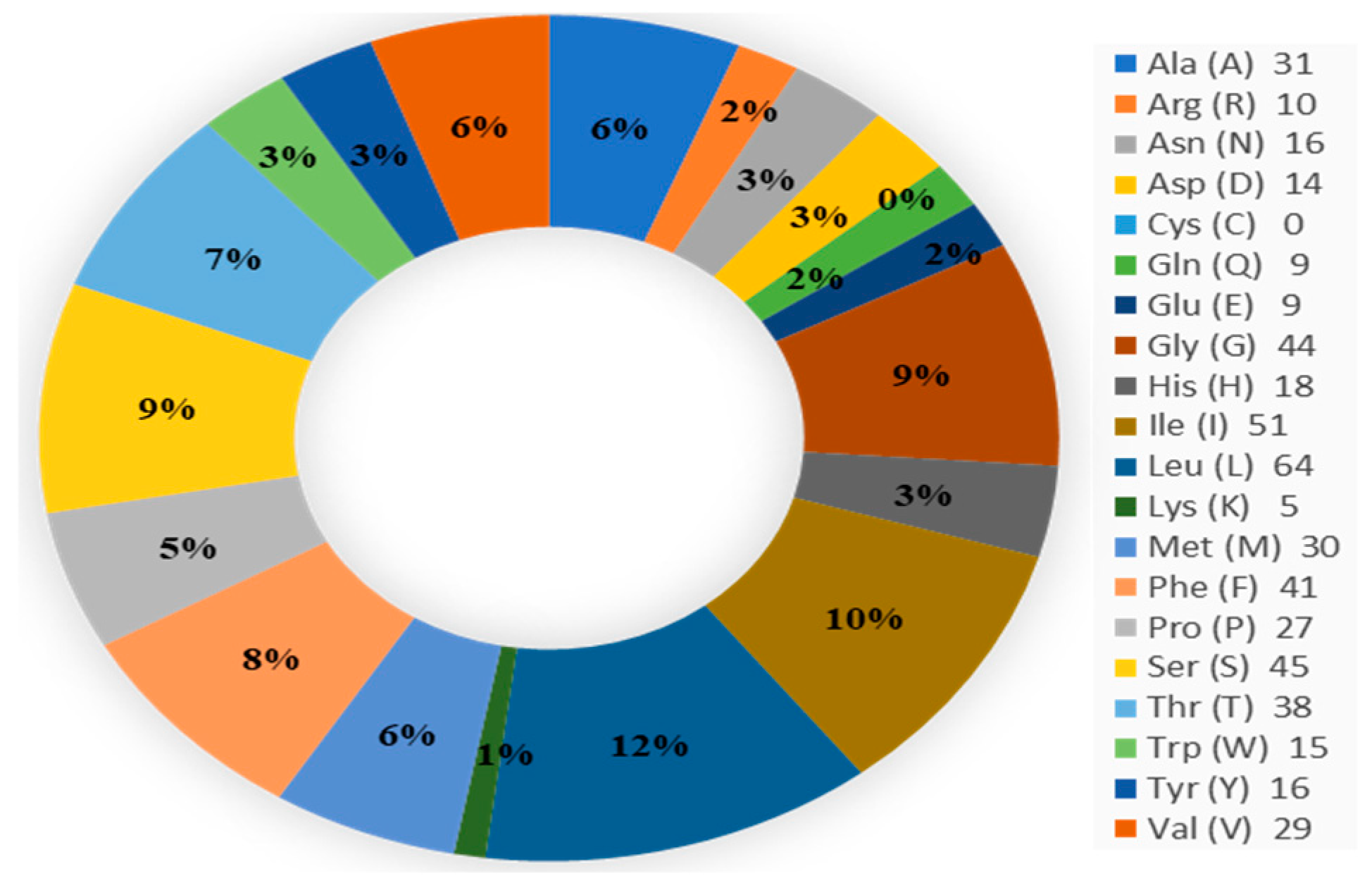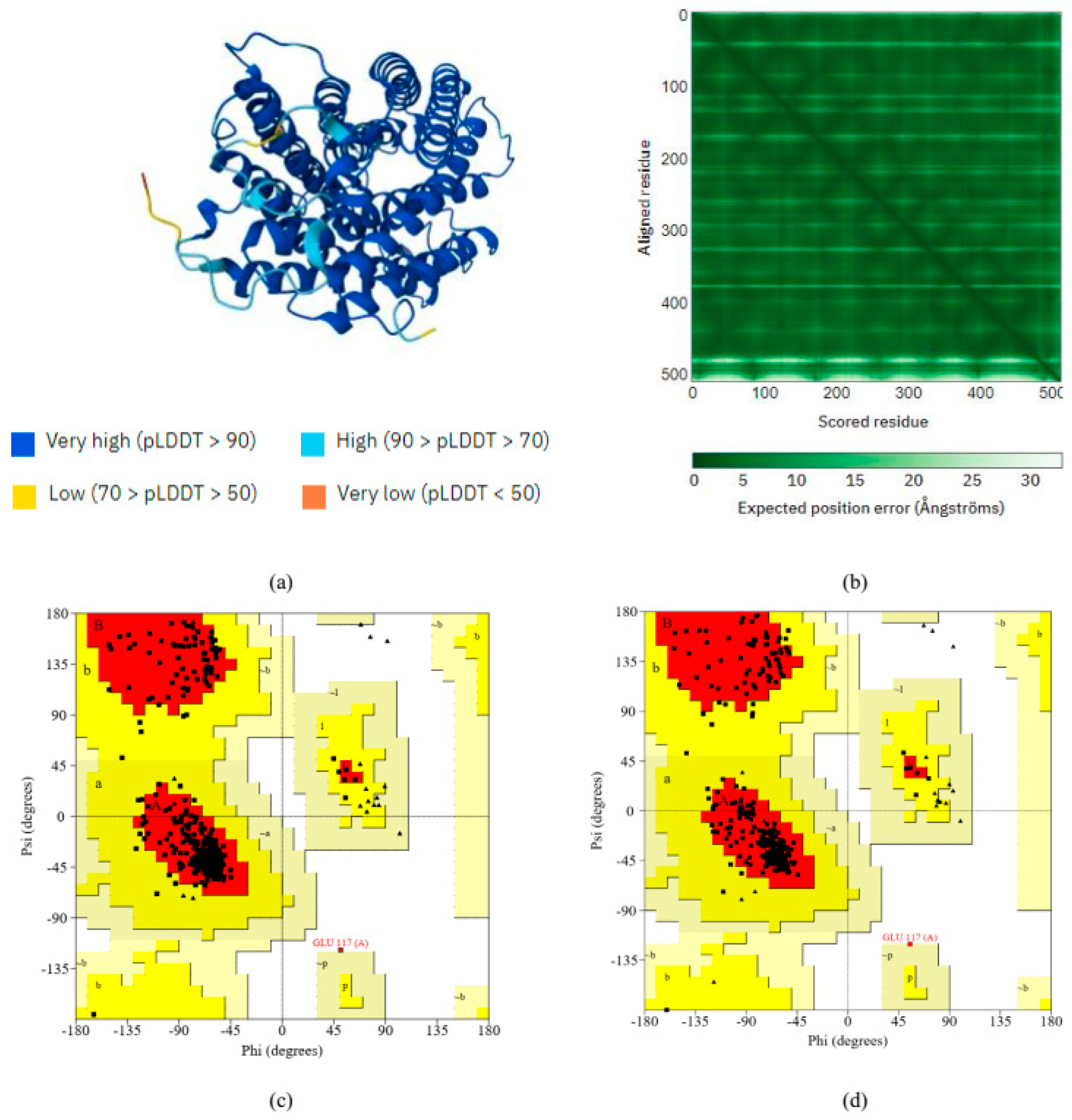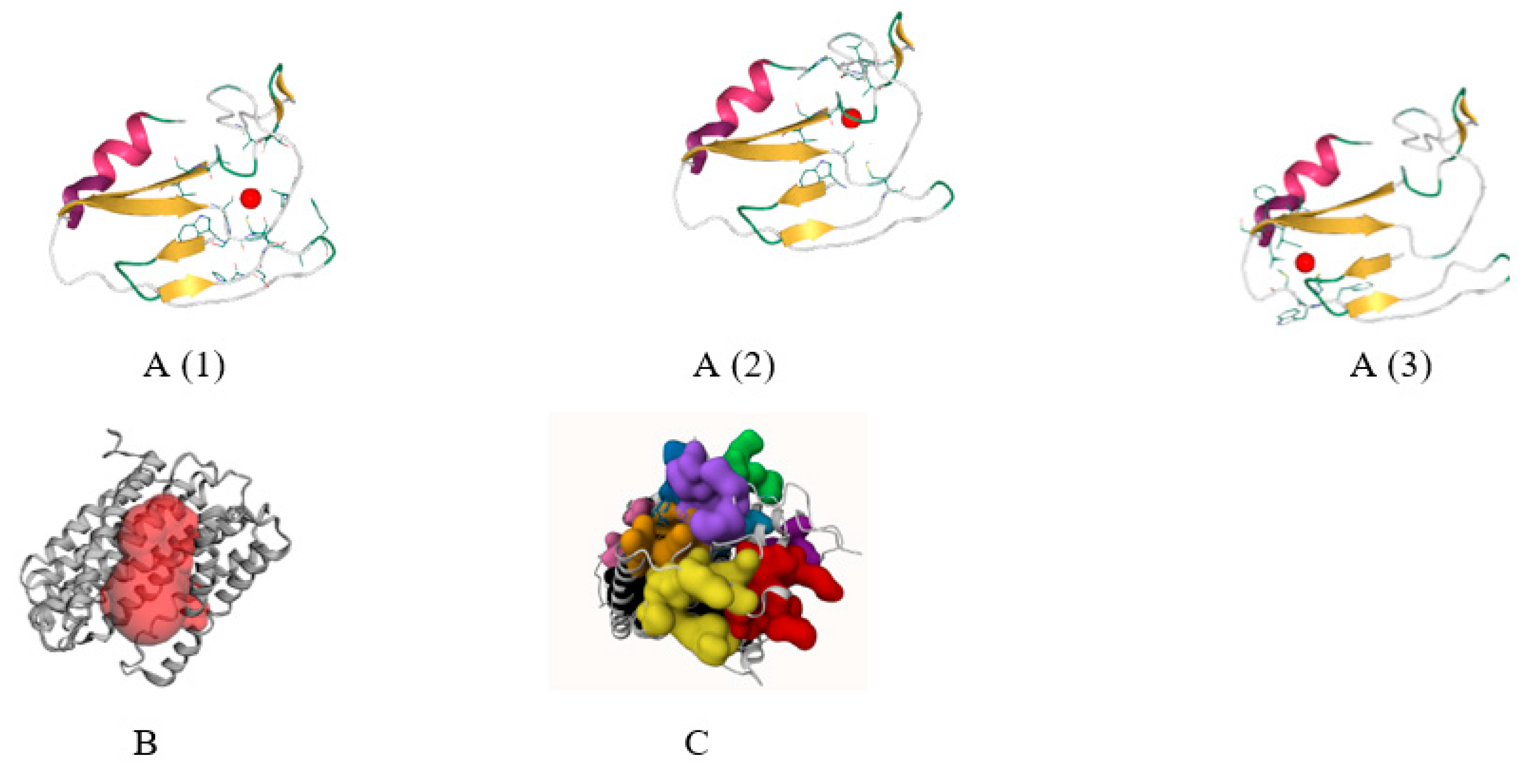Bioinformatics Approaches for the Molecular Characterization and Structural Elucidation of a Hypothetical Protein of Aedes albopictus †
Abstract
:1. Introduction
2. Materials and Methods
2.1. Selection of the Hypothetical Protein and Sequence Retrieval
2.2. Physicochemical Properties Analysis
2.3. Identification and Validation of the Secondary Structure
2.4. Three-Dimensional Structure Prediction and Validation
2.5. Ligand Binding Site or Active Site Determination
2.6. Pathogenecity Prediction
3. Results and Discussion
3.1. Protein Sequence Retrieval
3.2. Identification of the Physicochemical Properties
3.3. Identification and Validation of the Secondary Structure
3.4. The Three-Dimensional Protein Structure Anticipation and Assessment
3.5. Ligand Binding Site or Active Site Determination
3.6. Pathogenecity Prediction
4. Conclusions
Author Contributions
Funding
Data Availability Statement
Conflicts of Interest
References
- Gloria-Soria, A.; Payne, A.F.; Bialosuknia, S.M.; Stout, J.; Mathias, N.; Eastwood, G.; Ciota, A.T.; Kramer, L.D.; Armstrong, P.M. Vector competence of Aedes albopictus populations from the Northeastern United States for chikungunya, dengue, and Zika Viruses. Am. J. Trop. Med. Hyg. 2021, 104, 1123. [Google Scholar] [CrossRef]
- Ryan, S.J.; Carlson, C.J.; Mordecai, E.A.; Johnson, L.R. Global expansion and redistribution of Aedes-borne virus transmission risk with climate change. PLoS Neglected Trop. Dis. 2019, 13, e0007213. [Google Scholar] [CrossRef] [PubMed]
- Xie, L.M.; Yin, X.; Bi, J.; Luo, H.M.; Cao, X.J.; Ma, Y.W.; Liu, Y.L.; Su, J.W.; Lin, G.L.; Guo, X.G. Identification of potential biomarkers in dengue via integrated bioinformatic analysis. PLoS Neglected Trop. Dis. 2021, 15, e0009633. [Google Scholar] [CrossRef] [PubMed]
- Murray, N.E.A.; Quam, M.B.; Wilder-Smith, A. Epidemiology of dengue: Past, present and future prospects. Clin. Epidemiol. 2013, 5, 299–309. [Google Scholar] [PubMed]
- Al Asad, M.; Shorna, S.A.; Saikat, A.S.; Uddin, E. Structure-Based Functional Annotation of an Uncharacterized Conserved Protein of Acinetobacter baumannii: An in-silico Approach. Eng. Proc. 2023, 37, 25. [Google Scholar] [CrossRef]
- Zhao, J.; Cao, Y.; Zhang, L. Exploring the computational methods for protein-ligand binding site prediction. Comput. Struct. Biotechnol. J. 2020, 18, 417–426. [Google Scholar] [CrossRef]
- Dukka, B.K. Structure-based Methods for Computational Protein Functional Site Prediction. Comput. Struct. Biotechnol. J. 2013, 8, e201308005. [Google Scholar] [CrossRef] [PubMed]
- Martin-Martin, I.; Smith, L.B. Aedes albopictus D7 Salivary Protein Prevents Host Hemostasis and Inflammation. Biomolecules 2020, 10, 1372. [Google Scholar] [CrossRef] [PubMed]
- Saboia-Vahia, L.; Borges-Veloso, A.; Cuervo, P.; Junqueira, M.; Mesquita-Rodrigues, C.; Britto, C.; Domont, G.B.; De Jesus, J.B. Protein expression in the midgut of sugar-fed Aedes albopictus females. Parasites Vectors 2012, 5, 1–25. [Google Scholar] [CrossRef]
- Gong, J.; Chen, Y.; Pu, F.; Sun, P.; He, F.; Zhang, L.; Li, Y.; Ma, Z.; Wang, H. Understanding membrane protein drug targets in computational perspective. Curr. Drug Targets 2019, 20, 551–564. [Google Scholar] [CrossRef]
- Rahman, M.F.; Rahman, M.R.; Islam, T.; Zaman, T.; Shuvo, M.A.; Hossain, M.T.; Islam, M.R.; Karim, M.R.; Moni, M.A. A bioinformatics approach to decode core genes and molecular pathways shared by breast cancer and endometrial cancer. Inform. Med. Unlocked 2019, 17, 100274. [Google Scholar] [CrossRef]
- Mills, C.L.; Beuning, P.J.; Ondrechen, M.J. Biochemical functional predictions for protein structures of unknown or uncertain function. Comput. Struct. Biotechnol. J. 2015, 13, 182–191. [Google Scholar] [CrossRef] [PubMed]
- F de Azevedo, W. Molecular dynamics simulations of protein targets identified in Mycobacterium tuberculosis. Curr. Med. Chem. 2011, 18, 1353–1366. [Google Scholar] [CrossRef] [PubMed]
- Sayers, E.W.; Bolton, E.E.; Brister, J.R.; Canese, K.; Chan, J.; Comeau, D.C.; Connor, R.; Funk, K.; Kelly, C.; Kim, S.; et al. Database resources of the National Center for Biotechnology Information. Nucleic Acids Res. 2021, 49, D10–D17. [Google Scholar] [CrossRef]
- Gasteiger, E.; Gattiker, A.; Hoogland, C.; Ivanyi, I.; Appel, R.D.; Bairoch, A. ExPASy: The proteomics server for in-depth protein knowledge and analysis. Nucleic Acids Res. 2003, 31, 3784–3788. [Google Scholar] [CrossRef] [PubMed]
- Geourjon, C.; Deleage, G. SOPMA: Significant improvements in protein secondary structure prediction by consensus prediction from multiple alignments. Bioinformatics 1995, 11, 681–684. [Google Scholar] [CrossRef]
- Waterhouse, A.; Bertoni, M.; Bienert, S.; Studer, G.; Tauriello, G.; Gumienny, R.; Heer, F.T.; de Beer, T.A.; Rempfer, C.; Bordoli, L.; et al. SWISS-MODEL: Homology modelling of protein structures and complexes. Nucleic Acids Res. 2018, 46, W296–W303. [Google Scholar] [CrossRef] [PubMed]
- Varadi, M.; Bertoni, D.; Magana, P.; Paramval, U.; Pidruchna, I.; Radhakrishnan, M.; Tsenkov, M.; Nair, S.; Mirdita, M.; Yeo, J.; et al. AlphaFold Protein Structure Database in 2024: Providing structure coverage for over 214 million protein sequences. Nucleic Acids Res. 2024, 52, D368–D375. [Google Scholar] [CrossRef]
- Hollingsworth, S.A.; Karplus, P.A. A fresh look at the Ramachandran plot and the occurrence of standard structures in proteins. Biomol. Concepts 2010, 1, 271–283. [Google Scholar] [CrossRef]
- Jiménez, J.; Doerr, S.; Martínez-Rosell, G.; Rose, A.S.; De Fabritiis, G. DeepSite: Protein-binding site predictor using 3D-convolutional neural networks. Bioinformatics 2017, 33, 3036–3042. [Google Scholar] [CrossRef] [PubMed]
- Jendele, L.; Krivak, R.; Skoda, P.; Novotny, M.; Hoksza, D. PrankWeb: A web server for ligand binding site prediction and visualization. Nucleic Acids Res. 2019, 47, W345–W349. [Google Scholar] [CrossRef] [PubMed]
- Binkowski, T.A.; Naghibzadeh, S.; Liang, J. CASTp: Computed atlas of surface topography of proteins. Nucleic Acids Res. 2003, 31, 3352–3355. [Google Scholar] [CrossRef]
- Tomer, R.; Patiyal, S.; Dhall, A.; Raghava, G.P. Prediction of celiac disease associated epitopes and motifs in a protein. Front. Immunol. 2023, 14, 1056101. [Google Scholar] [CrossRef] [PubMed]
- Bendl, J.; Stourac, J.; Salanda, O.; Pavelka, A.; Wieben, E.D.; Zendulka, J.; Brezovsky, J.; Damborsky, J. PredictSNP: Robust and accurate consensus classifier for prediction of disease-related mutations. PLoS Comput. Biol. 2014, 10, e1003440. [Google Scholar] [CrossRef] [PubMed]
- Tavtigian, S.V.; Deffenbaugh, A.M.; Yin, L.; Judkins, T.; Scholl, T.; Samollow, P.B.; de Silva, D.; Zharkikh, A.; Thomas, A. Comprehensive statistical study of 452 BRCA1 missense substitutions with classification of eight recurrent substitutions as neutral. J. Med. Genet. 2006, 43, 295–305. [Google Scholar] [CrossRef]
- Sahay, A.; Piprodhe, A.; Pise, M. In silico analysis and homology modeling of strictosidine synthase involved in alkaloid biosynthesis in catharanthus roseus. J. Genet. Eng. Biotechnol. 2020, 18, 44. [Google Scholar] [CrossRef] [PubMed]
- Ikai, A. Thermostability and aliphatic index of globular proteins. J. Biochem. 1980, 88, 1895–1898. [Google Scholar] [PubMed]
- Bhowmick, S.; Saha, A.; AlFaris, N.A.; ALTamimi, J.Z.; ALOthman, Z.A.; Aldayel, T.S.; Wabaidur, S.M.; Islam, M.A. Structure-based identification of galectin-1 selective modulators in dietary food polyphenols: A pharmacoinformatics approach. Mol. Divers. 2022, 26, 1697–1714. [Google Scholar] [CrossRef]
- Mathe, E.; Olivier, M.; Kato, S.; Ishioka, C.; Hainaut, P.; Tavtigian, S.V. Computational approaches for predicting the biological effect of p53 missense mutations: A comparison of three sequence analysis based methods. Nucleic Acids Res. 2006, 34, 1317–1325. [Google Scholar] [CrossRef]
- Montenegro, L.R.; Lerário, A.M.; Nishi, M.Y.; Jorge, A.A.; Mendonca, B.B. Performance of mutation pathogenicity prediction tools on missense variants associated with 46, XY differences of sex development. Clinics 2021, 76, e2052. [Google Scholar] [CrossRef] [PubMed]




| Sequence | Start | End | Score | Hydrophobicity | Hydropathicity | Hydrophilicity | Charge | Mol wt. |
|---|---|---|---|---|---|---|---|---|
| MIFFMVMPIMIGGFGNWLVP | 63 | 82 | 0.34 | 0.34 | 1.65 | −1.31 | 0 | 2301.25 |
| FFMVMPIMIGGFGNWLVPLM | 65 | 84 | 0.32 | 0.33 | 1.61 | −1.31 | 0 | 2301.25 |
| MPIMIGGFGNWLVPLMLGAP | 69 | 88 | 0.32 | 0.27 | 1.2 | −1.03 | 0 | 2114.98 |
| FPRMNNMSFWMLPPSLTLLL | 92 | 111 | 0.32 | 0.05 | 0.54 | −0.89 | 1 | 2409.27 |
| MNNMSFWMLPPSLTLLLSSS | 95 | 114 | 0.32 | 0.08 | 0.58 | −0.86 | 0 | 2270.02 |
| NNMSFWMLPPSLTLLLSSSM | 96 | 115 | 0.32 | 0.08 | 0.58 | −0.86 | 0 | 2270.02 |
| NMSFWMLPPSLTLLLSSSMV | 97 | 116 | 0.4 | 0.13 | 0.97 | −0.95 | 0 | 2255.05 |
| MSFWMLPPSLTLLLSSSMVE | 98 | 117 | 0.33 | 0.14 | 0.97 | −0.81 | −1 | 2270.06 |
| SFWMLPPSLTLLLSSSMVEN | 99 | 118 | 0.36 | 0.09 | 0.7 | −0.73 | −1 | 2252.97 |
| FWMLPPSLTLLLSSSMVENG | 100 | 119 | 0.33 | 0.11 | 0.72 | −0.75 | −1 | 2222.95 |
| FIGVNLTFFPQHFLGLAGMP | 416 | 435 | 0.32 | 0.21 | 0.98 | −1.05 | 0.5 | 2206.95 |
| TPSFPMQLSSSIEWYHTLPP | 479 | 498 | 0.42 | −0.02 | −0.33 | −0.59 | −0.5 | 2318.92 |
| Mutants | GV | GD | Prediction 1 |
|---|---|---|---|
| M63P | 0.00 | 86.59 | Class C65 |
| F65M | 0.00 | 28.53 | Class C25 |
| M69P | 0.00 | 86.59 | Class C65 |
| F92L | 0.00 | 21.82 | Class C15 |
| M95S | 0.00 | 134.86 | Class C65 |
| N96M | 0.00 | 141.15 | Class C65 |
| N97V | 0.00 | 132.88 | Class C65 |
| M98E | 0.00 | 126.08 | Class C65 |
| S99N | 0.00 | 46.24 | Class C45 |
| F100G | 0.00 | 153.13 | Class C65 |
| F416P | 0.00 | 113.73 | Class C65 |
| T479P | 0.00 | 37.56 | Class C35 |
| Mutants | predictSNP | MAPP | PhD-SNP | Polyphen-2 | SIFT | SNAP | PANTHER | Ranging |
|---|---|---|---|---|---|---|---|---|
| M63P | 86.91% | 87.71% | 85.82% | 56.23% | 79.28% | 88.52% | 76.65% | 1 |
| F65M | 86.91% | 78.34% | 81.73% | 63.43% | 79.28% | 72.04% | 76.00% | 1 |
| M69P | 86.91% | 87.71% | 81.73% | 81.14% | 79.28% | 84.85% | 65.27% | 1 |
| F92L | 60.55% | 75.11% | 73.26% | 67.64% | 79.28% | 62.21% | 61.08% | 2 |
| M95S | 86.91% | 84.18% | 77.34% | 55.08% | 79.28% | 72.04% | 69.00% | 1 |
| N96M | 86.91% | 84.18% | 60.80% | 81.14% | 79.28% | 84.85% | 69.86% | 1 |
| N97V | 86.91% | 77.12% | 67.62% | 81.14% | 79.28% | 84.85% | 66.07% | 1 |
| M98E | 86.91% | 91.38% | 87.52% | 67.52% | 79.28% | 84.85% | 68.66% | 1 |
| S99N | 86.91% | 76.54% | 60.80% | 43.12% | 79.28% | 80.51% | 71.86% | 1 |
| F100G | 86.91% | 81.93% | 60.80% | 81.14% | 79.28% | 84.85% | 78.00% | 1 |
| F416P | 86.91% | 87.71% | 85.82% | 64.97% | 79.28% | 80.51% | 74.45% | 1 |
| T479P | 74% | 68% | 51% | 87% | 46% | 83% | 63% | 3 |
Disclaimer/Publisher’s Note: The statements, opinions and data contained in all publications are solely those of the individual author(s) and contributor(s) and not of MDPI and/or the editor(s). MDPI and/or the editor(s) disclaim responsibility for any injury to people or property resulting from any ideas, methods, instructions or products referred to in the content. |
© 2024 by the authors. Licensee MDPI, Basel, Switzerland. This article is an open access article distributed under the terms and conditions of the Creative Commons Attribution (CC BY) license (https://creativecommons.org/licenses/by/4.0/).
Share and Cite
Asad, M.A.; Shorna, S.A.; Mizan, M.; Nath, R.D.; Saikat, A.S.M.; Uddin, M.E. Bioinformatics Approaches for the Molecular Characterization and Structural Elucidation of a Hypothetical Protein of Aedes albopictus . Eng. Proc. 2024, 67, 14. https://doi.org/10.3390/engproc2024067014
Asad MA, Shorna SA, Mizan M, Nath RD, Saikat ASM, Uddin ME. Bioinformatics Approaches for the Molecular Characterization and Structural Elucidation of a Hypothetical Protein of Aedes albopictus . Engineering Proceedings. 2024; 67(1):14. https://doi.org/10.3390/engproc2024067014
Chicago/Turabian StyleAsad, Mamun Al, Surya Afrin Shorna, Md. Mizan, Rajib Deb Nath, Abu Saim Mohammad Saikat, and Md. Ekhlas Uddin. 2024. "Bioinformatics Approaches for the Molecular Characterization and Structural Elucidation of a Hypothetical Protein of Aedes albopictus " Engineering Proceedings 67, no. 1: 14. https://doi.org/10.3390/engproc2024067014







